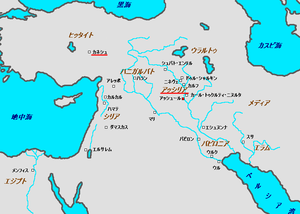ハンナハンナ
ハンナハンナ(Ḫannaḫanna)(ヒッタイト語の「ハンナ(祖母)」という言葉に由来する)はハッティ族の母神で、「偉大な祖母」という意味である[1]。ハンナハンナはメソポタミアの母神ディンギルマー(ニンフルサグ)と同一視された[2]。
ハンナハンナは楔型文字でDINGIR.MAḪ(「偉大なる神」の意)と書かれ、時にはNIN.TUと表され、フリギアの女神キュベレーの前身の一つと考えられている。[3]
クリストファー・シレンはハンナハンナはガルセスと関連していると述べている。
役割と信仰
ハンナハンナは母神として出産を司った。出産の儀式では、彼女が着座する場所が定められていなかったが、その代わりに妊婦の傍らにいるとされた[4]。ハンナハンナはカールム・カネシュで重要な女神とされた[5]。
神話
この男はイルヤンカ神話のフパシヤスかもしれない[6]。
テリピヌが姿を消した後、父である雷神タルフント(あるいはテシュブ)はハンナハンナに苦情を言った。ハンナハンナはテリピヌ捜索のためタルフントを送り出した。タルフントが諦めるとハンナハンナはテリピヌを見つけるよう命令し、ミツバチを派遣した。ミツバチはテリピヌを見つけると、手足を刺し、目と足を蜜蝋で拭いて、神を清め、強くした。
彼女は、海神の娘である自分とテリピヌの結婚のために、結納金をタルフントから海神に支払わせた。
イナラに相談を受けて、ハンナハンナはイナラに一人の男と土地を与えた。 Soon after, Inara went missing and when Ḫannaḫanna was informed of this by the Storm-god's bee, she apparently began a search with the help of her female attendant. Apparently, like Demeter, Ḫannaḫanna disappears for a while in a fit of anger and while she is gone, cattle and sheep are stifled and mothers, both human and animal take no account of their children.
After her anger is banished to the Dark Earth, she returns rejoicing, and mothers care once again for their kin. Another means of banishing her anger was through burning brushwood and allowing the vapor to enter her body. Either in this or another text she appears to consult with the Sun god and the War god, but much of the text is missing.
Ḫannaḫanna and the Biblical Hannah
Although Ḫannaḫanna is similar to the Biblical name Hannah, mother of Samuel (according to 1 Kings), the Canaanite Anat, and the Christian Saint Anne, these are coincidental. The names Anne and Hannah derive from Hebrew Channah, meaning "favor" or "grace," [7] while Anat may be from a Semitic root meaning "water spring."[8]
See also
Sources
References
- ↑ Volkert Haas, Heidemarie Koch: Religionen des alten Orients: Hethiter und Iran. Göttingen 2011, S. 224.
- ↑ Piotr Taracha: Religions of Second Millennium Anatolia. Wiesbaden 2009, S. 125.
- ↑ Fertility and Gender in the Ancient Near East
- ↑ Volkert Haas: Die hethitische Literatur. Berlin 2006, S. 198.
- ↑ Piotr Taracha: Religions of Second Millennium Anatolia. Wiesbaden 2009, S. 31.
- ↑ Volkert Haas: Die hethitische Literatur. Berlin 2006, S. 97 f.
- ↑ http://www.behindthename.com/name/hannah
- ↑ http://www.behindthename.com/name/anat-1

